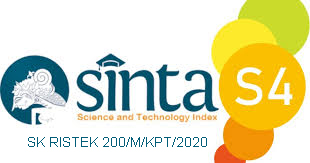Business Intelligence Using N-Beats And Rnn Methods End Influence On Decision Making In The Flexible Packaging Manufacturing
Abstract
Keywords
Full Text:
PDFReferences
S. Mudgal et al., “Deep learning for entity matching: A design space exploration,” Proc. 2018 Int. Conf. Manag. Data, pp. 19–34, 2018.
H. Apaydin, H. Feizi, M. T. Sattari, M. S. Colak, S. Shamshirband, and K. W. Chau, “Comparative analysis of recurrent neural network architectures for reservoir inflow forecasting,” vol. 12, no. 5, p. 1500, 2020.
E. J. C. Lopes and R. A. da Costa Bianchi, “Short-term prediction for Ethereum with Deep Neural Networks,” Work. Artif. Intell. Financ., pp. 1–12, 2022.
B. N. Oreshkin, D. Carpov, N. Chapados, and Y. Bengio, “N-BEATS: Neural basis expansion analysis for interpretable time series forecasting,” arXiv Prepr. arXiv, vol. 1905.10437, 2019.
D. . Adytia, D. Saepudin, S. R. Pudjaprasetya, S. Husrin, and A. Sopaheluwakan, “A deep learning approach for wave forecasting based on a spatially correlated wind feature, with a case thesis in the Java Sea, Indonesia,” Fluids, vol. 7, no. 1, p. 39, 2022.
B. Puszkarski, K. Hryniów, and G. Sarwas, “N-beats for heart dysfunction classification,” 2021 Comput. Cardiol., vol. 48, pp. 1–4, 2021.
R. Islam, K. Desai, and J. Quarles, “Towards Forecasting the Onset of Cybersickness by Fusing Physiological, Head-tracking and Eye-tracking with Multimodal Deep Fusion Network”.
A. Sherstinsky, “Fundamentals of recurrent neural network (RNN) and long short-term memory (LSTM) network,” Phys. D Nonlinear Phenom., vol. 404, p. 132306, 2020.
N. Reski, “Tingkat Minat Belajar Siswa Kelas Ix Smpn 11 Kota Sungai Penuh,” J. Inov. Penelit., vol. 1, no. 11, pp. 2485–2490, 2021.
V. Singhal, N. Neeraj, J. Mathew, and M. Agarwal, “Fusion of Wavelet Decomposition and N-BEATS for improved Stock Market Forecasting,” 2022.
I. H. Sarker, “Deep learning: a comprehensive overview on techniques, taxonomy, applications and research directions,” SN Comput. Sci., vol. 2, no. 6, pp. 1–20, 2021.
A. Sbrana, A. L. D. Rossi, and M. C. Naldi, “N-BEATS-RNN: deep learning for time series forecasting,” 2020 19th IEEE Int. Conf. Mach. Learn. Appl., pp. 765–768, 2020.
E. Stevenson, V. Rodríguez-Fernández, E. Minisci, and D. Camacho Fernandez, “A deep learning approach to space weather proxy forecasting for orbital prediction,” 2020.
Y. Fu, D. Wu, and B. Boulet, “Reinforcement learning based dynamic model combination for time series forecasting,” 2022.
S. Zeng, F. Graf, C. Hofer, and R. Kwitt, “Topological attention for time series forecasting,” Adv. Neural Inf. Process. Syst., vol. 34, pp. 24871–24882, 2021.
N. Widmark, “Short-term electricity consumption forecasting using deep learning and external variables,” 2022.
D. Putz, M. Gumhalter, and H. Auer, “A novel approach to multi-horizon wind power forecasting based on deep neural architecture,” Renew. Energy, vol. 178, pp. 494–505, 2021.
L. Alzubaidi et al., “Review of deep learning: Concepts, CNN architectures, challenges, applications, future directions,” J. big Data, vol. 8, no. 1, pp. 1–74, 2021.
A. Bulatov, “Forecasting Bitcoin Prices Using N-BEATS Deep Learning Architecture,” 2020.
E. Stevenson, V. Rodriguez-Fernandez, E. Minisci, and D. Camacho, “A deep learning approach to solar radio flux forecasting,” Acta Astronaut., vol. 193, pp. 595–606, 2022.
V. Le Guen and N. Thome, “Deep Time Series Forecasting with Shape and Temporal Criteria,” IEEE Trans. Pattern Anal. Mach. Intell., 2022.
DOI: https://doi.org/10.31326/jisa.v6i1.1626
Refbacks
- There are currently no refbacks.
Copyright (c) 2023 Eko Wahyudi,Tjong Wan Sen

This work is licensed under a Creative Commons Attribution-ShareAlike 4.0 International License.
JOURNAL IDENTITY
Journal Name: JISA (Jurnal Informatika dan Sains)
e-ISSN: 2614-8404, p-ISSN: 2776-3234
Publisher: Program Studi Teknik Informatika Universitas Trilogi
Publication Schedule: June and December
Language: English
APC: The Journal Charges Fees for Publishing
Indexing: EBSCO , DOAJ, Google Scholar, Arsip Relawan Jurnal Indonesia, Directory of Research Journals Indexing, Index Copernicus International, PKP Index, Science and Technology Index (SINTA, S4) , Garuda Index
OAI address: http://trilogi.ac.id/journal/ks/index.php/JISA/oai
Contact: jisa@trilogi.ac.id
Sponsored by: DOI – Digital Object Identifier Crossref, Universitas Trilogi
In Collaboration With: Indonesian Artificial Intelligent Ecosystem(IAIE), Relawan Jurnal Indonesia, Jurnal Teknologi dan Sistem Komputer (JTSiskom)
JISA (Jurnal Informatika dan Sains) is Published by Program Studi Teknik Informatika, Universitas Trilogi under Creative Commons Attribution-ShareAlike 4.0 International License.


















